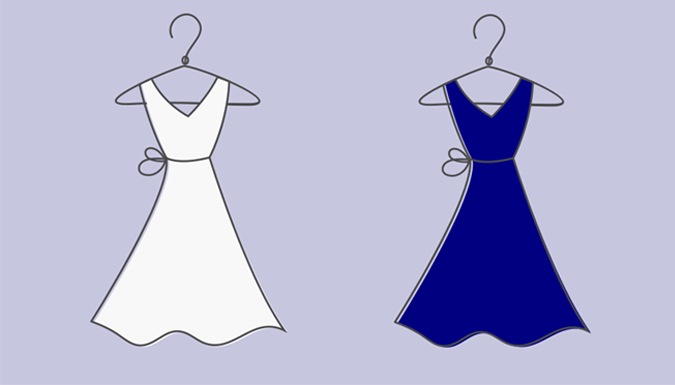A look at a current news item through the lens of different Gale electronic resources.
By Michelle Eickmeyer
The Internet exploded last night. While this seems to happen more and more often, this particular episode highlighted a few interesting things to me. First, people care passionately about seemingly random things. People also seem to have very strong opinions on things which, in the sweep of things, don’t really matter. It was also an interesting display of how quickly anything — valuable or not — can infiltrate just about everyone’s social feeds. Even while the “whole world” (read: U.S.) is sleeping. Most importantly, lessons of ‘things aren’t always what they seem’ and ‘just because its on the internet doesn’t make it true’ abound.
Just to catch everyone up, a “controversy” spawned last night about whether a certain photographed dress was “white and gold” or “blue and black.” In said photo, I see white and gold. I’ve also seen pictures of a woman wearing the same dress at a wedding, where it is clearly blue and black. This morning, ABC ran a segment about it. It’s good background, and shows all of the images you need to make a decision. Or find ammunition for your counter-argument. Up to you. This article from The Atlantic also looks at the great debate.
Here’s a look through 4 online resources from Gale.
Communication and Mass Media Collection on InfoTrac
The all knowing ‘they’ say that all press is good press. Is non-attributed mention of this dress good for anyone? Should it be? Could it be? What are the challenges & benefits of being unattributed to a positive thing v. being associated to a negative thing? Dress by unknown designer is top trending item for more than 12 hours. Shooting victim in racially charged investigation carries named fruit candy. Photo of compact pickup truck shown with 20 armed anti-U.S. fighters on cover of prominent international news magazine. Which side is better? This collection of more than 250 journals is dedicated to exploring these questions and more.
19th Century UK Periodicals
Wanting to look at more dresses? We’ve had a lot of traffic on some recent posts about Downton Abbey. If Downton fashion is your thing, take a look at the real thing in these primary source pages. Adverts from the 1800s? Yeah. And they’re pretty cool. And if fashion isn’t your thing, see what else was going on there and then. It’s very cool. I recommend liquor or farm equipment searches too.
Opposing Viewpoints in Context
Regardless of the “value” you see in this particular conversation, the ability to purposefully, succinctly, and responsibly argue is crucial. Also important to that ability is having access to credible, unbiased resources on both sides of the argument. So while it may seem frivolous to “fight” about the color of a dress, the idea of having a well thought out and supported argument is the same, regardless of the topic.
Psychology Collection on InfoTrac
How does your brain recognize color and what do some people see color differently, even beyond any physical “limitation”? Do right brainers see blue differently than left brainers? Does the concept of color limit perception? Are you more likely to see the blue dress after seeing a more obviously blue picture of it? (See the GMA clip above – this happens to Robin.) But beyond color (and this might seem like a stretch, but bear with me), what does this exercise change or tell us about trust? Trust for what we believe, and see, and believe or see in someone else? Everyone’s abs, or butt-shots, or waistline, or hair color, or …. If this was the straw that broke the internet’s back, where do we go from here?
*apologies – the catalog page for the Psychology Collection is in revision and currently unavailable. The link will direct you to the page for the custom journal section of Infotrac.
[alert-info]
 About the Author
About the Author
Michelle is an “anytime!” traveler and language enthusiast. She has degrees in talking from Central Michigan and Michigan State University. She is currently becoming a runner and used to play golf in high school.
[/alert-info]Sneakers

